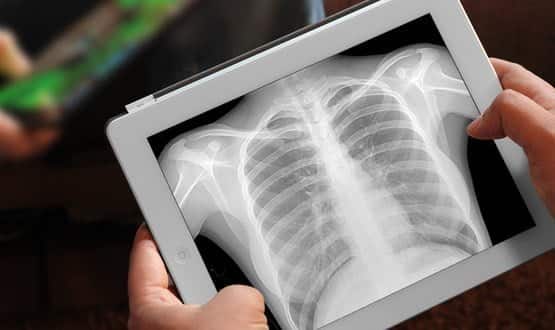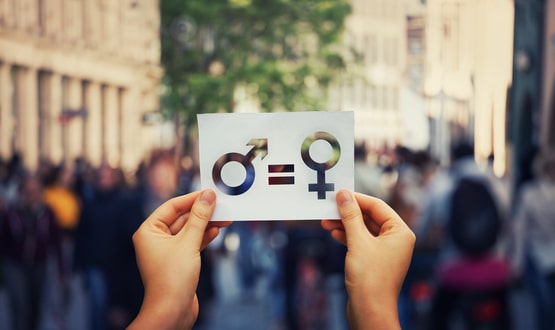Screenshot
- 4 March 2013

Little by little, mobile devices that were first targeted at consumers are gaining acceptance as viable professional tools within healthcare.
Champions of ‘Bring Your Own Device’ strategies, like that implemented at Royal Liverpool and Broadgreen University Hospitals NHS Foundation Trust last year, are clearly buoyed by the prospect of iPads and the like finding their way into the clinician’s toolkit.
However, many radiologists say the jury is still out when it comes to their area of work. Valuable as they may be for speeding communication between individuals and boosting productivity on the move, most believe tablets and smartphones lack the technological characteristics to accurately diagnose clinical images.
Being designed principally for the consumer market, their displays cannot be calibrated, for example.
In terms of viewing angles, brightness and contrast levels, many tablets can match diagnostic monitors, says Dr Erik Ranschaert, staff radiologist at Jeroen Bosch Ziekenhuis teaching hospital in the Netherlands.
However, despite being far cheaper, he warns that iPads can’t compete with the screen size and resolution of modern medical displays.
"It’s essential to have a calibration tool on display on a diagnostic workstation to make a confident diagnosis,” he told January’s Arab Health conference in Dubai.
“IPads have high-quality displays, but they don’t have DICOM calibration, so there’s no quality assurance during the display’s life because it’s not being monitored, and there’s no contrast control. There are solutions, but they’re not using the calibration software as we know it in the diagnostic workstation."
Moreover, US public health watchdog, the Food and Drug Administration, insists displays must have a 51-61cm diagonal viewable area for diagnostic purposes, unless a larger panel is used to serve as a pair of monitors. The iPad screen size is only 25cm. For clinical review, however, anything goes, says Dr Ranschaert.
Clear inadequacies
Patrick O’Brien, managing director of Tracline, a key partner in delivering Motion’s mobile point of care strategy in the UK, agrees. “Mobile devices are already widely used in the NHS for tasks like prescribing,” he says. “In radiology, too, they are fine for reviewing, which currently accounts for about 90% of their use.
“But I really wouldn’t use any current mobile device, including our own, for diagnostic purposes,” he says. “None of them are good enough and any clinician who knows their salt will tell you that.
“No radiologist wants to read a chest x-ray off an iPad – it’s not what it’s designed for. In fact, I don’t know of any radiologist that would put their name to diagnosing anything using a hand-held device.”
To be of primary use in diagnostics, tablet technology needs to improve considerably, says Karen Senior, sales manager UK and Ireland at GE Healthcare, and a qualified radiologist.
“At present, the screen size is inadequate for viewing the amount of information and images needed to make accurate diagnoses,” she says. “That will require a technology leap – say a 3D hologram that pops up out of the tablet – which will probably happen at some point.”
Her thoughts are echoed by Maxine Clarke, PACS and radiology IT manager at Norfolk and Norwich University Hospitals NHS Foundation Trust, who says iPads and tablets may well have reasonably high definition screens, but they can’t possibly replicate the reporting-type monitors used in picture archiving and communications systems.
“In the case of plain film imaging, for example, Royal College of Radiologists guidelines stipulate the use of 3MP monochrome monitors when making diagnoses. From a quality perspective, it just wouldn’t make sense to look at a transverse body part on a tiny iPad screen, for instance.
“That’s why trusts provide radiologists with massive screens featuring high-resolution graphics capabilities, 3D, colour and so forth. For the moment, I believe their sheer size makes tablet devices of dubious value to image diagnosis.”
Positive response
Notwithstanding their current physical limitations, the question remains: can radiology departments afford not to adopt mobile devices in the longer term?
Stephen Hayward, IT director at Spire Healthcare, thinks not. Last year, his company implemented Carestream’s Vue Motion technology, giving clinicians secure, on-demand access to patient images on its PACS from 37 sites using iPads and tablet devices.
“In order to grow Spire’s business we need to differentiate our services from those of our competitors so that our consultants want to bring their patients to us and consequently grow our revenues,” he says.
“We constantly look at how we can use technology to make us superior and provide a better service to both patients and consultants. Obviously, our competitors will catch up and take the system at some stage, but for now it has given Spire a boost and enhanced our reputation.”
“Reaction from our consultants has been hugely positive,” he adds. “They are very impressed with the quality of the images for display and find it a great convenience in their work.
It’s a fantastic product, intuitive to use, and the image resolution is excellent. Having access to care records and reports on a mobile device at the clinician’s fingertips will be a great boon going forward.”
Patient reassurance
From a quality of care perspective, Senior also believes that tablets are already proving to be viable proposition. “Specialists on call are using our mobile apps to view patient images and data – both current and historical – on iPads and Android devices,” she says.
“That’s not necessarily for clinical diagnostic purposes, but rather to give valuable second opinions quickly in emergency situations. Clearly, the faster decisions are made, the more favourable outcomes are likely to be; but I’m not advocating that radiologists carry out reporting on a BlackBerry.
“As well as reducing costs by making staff more productive, mobile devices also enable clinicians to explain radiology results and discuss next steps at the bedside, which can be very reassuring for patients.”
Kate Parkes, radiology clinical system manager at Birmingham Children’s Hospital NHS Foundation Trust, is equally enthusiastic. She says the Agfa XERO Technology Viewer that it implemented last year gives clinicians a single point of access, thereby improving communication across multidisciplinary teams and with patients.
“The patient and family are more informed about their condition through discussion with their clinician, as there is access to the all information in the clinic or on the ward,” she says.
“There is more efficient use of clinicians’ time, as all the information is available when and wherever it’s needed – also meaning there’s a reduction in the duplication of tasks. Our clinicians are finding the ability to securely view XERO on iPads a very exciting and popular development.”
Security concerns
As tablet devices gain ground in hospitals, however, radiologists and clinicians need to be aware of the associated risks inherent in mobility.
One concern for NHS trusts – particularly in the light of well-publicised security breaches within government departments over the years – is that mobile devices are easily lost.
And if confidential patient data is stored on them, it can potentially be accessed by anyone. It’s a worry that’s likely to be accentuated by the BOYD model many trusts are adopting or considering.
“With our technology, that’s no longer a problem,” says Agfa Healthcare marketing manager, Paul Jackson. “No data is ever cached on the mobile device, which is used for viewing only; so no patient information remains on the unit after a session. What’s more, all access is authenticated, encrypted and completely controlled by the IT department.”
A new generation
Even so, it’s doubtful whether iPads equipped with clinical apps for medical image reporting will replace diagnostic workstations anytime soon.
“Whilst they offer the benefit of viewing images on the fly when a diagnostic workstation is unavailable, most experts agree that they currently lack the functionality radiologists need to evaluate subtle images,” says Senior.
“That said, I’ve no doubt that the demand for mobile technology in imaging informatics will grow. Let’s not forget that tomorrow’s radiologists and clinicians have never worked with film. They’re growing up in a world of mobile apps and will expect it in their working life too. It’s just a natural progression.”
Dr Erik Ranschaert is among the speakers at a special focus session ‘Tablets in radiology: friend or foe’ at 16.00 on 11 March in Room F1 at ECR 2013 in Vienna.
The session will include: a technical overview and radiological features of the tablet computer; reading DICOM images on the tablet; a critical appraisal of mobile teleradiology with tablet computers; plus a panel discussion entitled: “Are we ready and confident enough to use tablet computers in clinical practice? How and when?” More details on page 108 of the conference programme.




